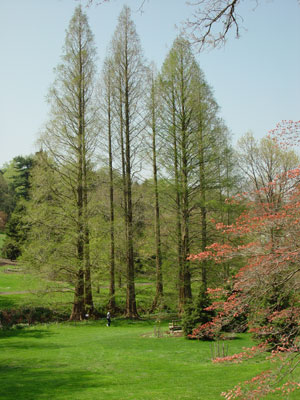
http://www.metasequoia.org/
Posted on 08/20/2007 6:04:45 PM PDT by Coleus
The wind schusses through the grove of tall trees, rustling their soft, bright green needles that, strangely enough, are the color of inchworms. The morning sun spills down through the branches, casting the glade in a pale green light, a hue unlike anything the visitors have ever seen. These metasequoia trees -- all 360 of them -- are living fossils, the lonely representatives of a species that once filled the forests of the Americas, Europe and Asia when dinosaurs roamed the Earth more than 60 million to 100 million years ago. The stand of trees, located on a Rutgers University research farm in East Brunswick, represents one of the world's greatest collections of metasequoia. Only China has more.
Earlier this week, a band of students visited the grove on busy Ryders Lane as part of an experiment they are staging this summer to bring the most modern of tools to bear on this most ancient -- and poorly understood -- species. Rutgers students Sasha Eisenman, Ari Novy and Ramya Raviram are analyzing the DNA of 43 metasequoia in order to come up with distinct "fingerprints" -- a unique genetic sequence -- showing how closely related the trees may be to each other.
"We are trying to understand the genetic diversity of the trees," said Eisenman, a plant biology graduate student leading the experiment. Such knowledge is crucial, he said, if the trees are to be used as a living seed bank. Seed banks are important because they preserve the genetic material of plants, known as the "germplasm," which contain the genes shared by those in a species and those that make each specimen unique.
(Excerpt) Read more at nj.com ...

My English teacher would have given this an A plus...for all those ridiculous descriptive words they lust after.
thanks, i was wondering what they looked like.
The “modern version” is the Tamarac
Botanical: Larix Americana (MICHX.)
Family: N.O. Coniferae
-—Synonyms-—American Larch. Black Larch. Hackmatack. Pinus Pendula (Salisb.).
-—Habitat-—Eastern North America.
also loses it’s needles for winter - the “naked xmas tree”
Very cool. They classify them as redwoods I think, from the links from a site. I wonder if anyone has looked at them for commercial viability . . . if they grow fast or have attractive wood they could make a huge comeback with the logging companies planting them. Looks like they would be easy to log and strip.
I read somewhere that a grove of ancient “dinosaur” trees were discovered in an obscure niche in Australia. The seeds, I heard, were going for about $80 each.
Anyone remember this?
http://earthsci.org/fossils/geotime/wollemi/wollemi.htm
The single known population of Wollemi Pine is in a rainforest gully within Wollemi National
Park (487,648 ha). This is the State’s largest wilderness area - located West of the Putty Road
between Sydney and the Hunter Valley.
Google “dinosaur tree” australia
I’ve got 2 of these in my back yard (bought at a nursery). Haven’t done any DNA testing on them. Handsome trees, grow pretty fast.
Hell! I thought this was about the US Senate!!...
If they’re like Tamaracs, they grow in very marshy environments.
Tamaracs around Northern Wisconsin were harvested for pilings, the wood is extremely resistant to rot. It dries hard and burns hot. You can’t drive a nail in it, unless it’s still green.
We would get to them using winter roads, kinda like the ice road truckers, when the swamps were frozen.
Do the birds like them?
Good. Let them do the research.
And they looked like the trees in the picture.

And a disclaimer for Bill O'Reilly: Just because I posted a picture of a KKK recruiter does not in any way mean I support the racist, supremacist ideology of the Klan or the Democrats that keep this living fossil in Congress.
Only the archaeopteryxes.
Do modern species like them as much as any other tree?
Dawn Redwoods or ‘Dinosaur Trees’ are really not all that different than the well known bald cypress. In fact the first Dawn Redwood fossils found in 1855 were at first mistaken for bald cypress fossils.
As far as living fossils go, my favorite is the ginkgo biloba tree, of which fossils from 270 million years ago have been found, predating dinosaurs, and it shares traits of cycads (that look like ferns or palms) with which the ginkgo is considered among the most primitive seed bearing plants.
 |
||
| · join · view topics · view or post blog · bookmark · post new topic · | ||
Disclaimer: Opinions posted on Free Republic are those of the individual posters and do not necessarily represent the opinion of Free Republic or its management. All materials posted herein are protected by copyright law and the exemption for fair use of copyrighted works.